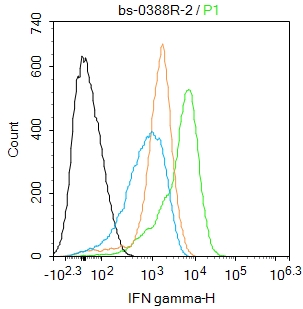
Rabbit Anti-IFN gamma antibody
IFNG; IFG; IFI; IFN Gamma; IFN Immune; IFN-gamma; IFNG; IFNG_HUMAN; Immune Interferon; Interferon gamma; Interferon Gamma Precursor; Macrophage Activating Factor; MAF; T Cell Interferon; Type II Interferon; hIFN-gamma.
View History [Clear]
Details
Product Name IFN gamma Chinese Name γ-Interferon/γ-IFN抗体 Alias IFNG; IFG; IFI; IFN Gamma; IFN Immune; IFN-gamma; IFNG; IFNG_HUMAN; Immune Interferon; Interferon gamma; Interferon Gamma Precursor; Macrophage Activating Factor; MAF; T Cell Interferon; Type II Interferon; hIFN-gamma. Research Area Tumour immunology cell factor Immunogen Species Rabbit Clonality Polyclonal React Species Human, Applications WB=1:500-2000 ELISA=1:5000-10000 IHC-P=1:100-500 IHC-F=1:100-500 Flow-Cyt=2ug/Test IF=1:100-500 (Paraffin sections need antigen repair)
not yet tested in other applications.
optimal dilutions/concentrations should be determined by the end user.Theoretical molecular weight 17kDa Cellular localization Secretory protein Form Liquid Concentration 1mg/ml immunogen Full length of human IFN gamma Recombinded. Lsotype IgG Purification affinity purified by Protein A Buffer Solution 0.01M TBS(pH7.4) with 1% BSA, 0.03% Proclin300 and 50% Glycerol. Storage Shipped at 4℃. Store at -20 °C for one year. Avoid repeated freeze/thaw cycles. Attention This product as supplied is intended for research use only, not for use in human, therapeutic or diagnostic applications. PubMed PubMed Product Detail Mammalian Interferon gamma is mainly produced by T lymphocytes and NK cells. It is a pleiotropic cytokine involved in the regulation of nearly all phases of immune and inflammatory responses,including the activation, growth and differentiation of T cell, B cells, macrophages, NK cells and other cell types such as endothelial cells and fibroblasts. It has weak antiviral and antiproliferative activity, and poteniates the antiviral and anti tumor effects of IFN alpha / beta (type I interferon). It is upregulated by IL2, FGF basic, EGF and downregulated by vitamin D3 or DMN. Labile at pH 2.
Function:
Produced by lymphocytes activated by specific antigens or mitogens. IFN-gamma, in addition to having antiviral activity, has important immunoregulatory functions. It is a potent activator of macrophages, it has antiproliferative effects on transformed cells and it can potentiate the antiviral and antitumor effects of the type I interferons.
Subunit:
Homodimer.
Subcellular Location:
Secreted.
Tissue Specificity:
Released primarily from activated T ymphocytes.
Post-translational modifications:
Proteolytic processing produces C-terminal heterogeneity, with proteins ending alternatively at Gly-150, Met-157 or Gly-161.
DISEASE:
In Caucasians, genetic variation in IFNG is associated with the risk of aplastic anemia (AA) [MIM:609135]. AA is a rare disease in which the reduction of the circulating blood cells results from damage to the stem cell pool in bone marrow. In most patients, the stem cell lesion is caused by an autoimmune attack. T-lymphocytes, activated by an endogenous or exogenous, and most often unknown antigenic stimulus, secrete cytokines, including IFN-gamma, which would in turn be able to suppress hematopoiesis.
Similarity:
Belongs to the type II (or gamma) interferon family.
SWISS:
P01579
Gene ID:
3458
Database links:
Entrez Gene: 3458 Human
Entrez Gene: 15978 Mouse
Omim: 147570 Human
SwissProt: P01579 Human
SwissProt: P01580 Mouse
Unigene: 856 Human
Unigene: 240327 Mouse
Product Picture
Primary Antibody (green line): Rabbit Anti-IFN gamma antibody (SL0388R)
Dilution: 2ug/Test;
Secondary Antibody : Goat anti-rabbit IgG-FITC
Dilution: 0.5ug/Test.
Protocol
The cells were treated with TPA (40 nM, 4 hr), Ionomycin (2 μM, 4 hr), and Brefeldin A (1 μg/mL).The cells were Fixed with 4% PFA (10min at room temperature)and then permeabilized with 0.1% PBST for 20 min at room temperature.The cells were then incubated in 5%BSA to block non-specific protein-protein interactions for 30 min at room temperature.Cells stained with Primary Antibody for 30 min at room temperature. The secondary antibody used for 40 min at room temperature. Acquisition of 20,000 events was performed.
Partial purchase records(bought amounts latest0)
No one bought this product
User Comment(Total0User Comment Num)
- No comment



 +86 571 56623320
+86 571 56623320




